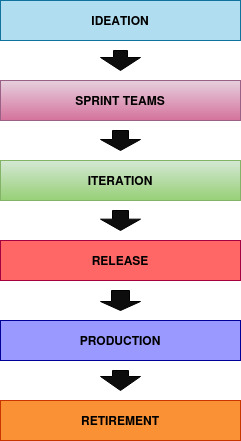Description
Agile workflow defines as a combination of the stages, involving the creation of an application or software. It is an application’s life cycle, from its creation to until its end. It also defines as the series of steps included in the development of a system or application.
Advantages
- Customer satisfaction by delivering useful software promptly, continuously.
- Continuous commitment to good design and technical excellence.
- Focuses on people and interactions rather than processes and tools.
- Constantly respond to changing circumstances.
- Even it welcomes late changes in requirements.
Disadvantages
- In case of some large software deliverables, it is difficult to assess the effort required at the beginning of software development.
- The effort required at the beginning of software development.
- If the customer is not sure about the final result, the project can easily get out of track.
- Only senior programmers are able to take the required decisions during the development process. Therefore, it has no place for new programmers.
- Agile development also sometimes fails due to unrealistic expectations.
Agile Workflow
IDEATION
This step involves identifying the ideas of the project and also analyzing them for advantages and disadvantages of each and every project idea attached to them and choosing the one that is worthwhile or best suited.
SPRINT TEAMS
Having discussion with stakeholder, project execution starts by assigning tasks within the decided timeline to the chosen agile team.
ITERATION
At the end of a sprint, the team preparing to produce a workable product and start working on the first iteration.
RELEASE
This stage concerns the production phase and the quality team will test the product’s functionality and rectify the errors if persists.
PRODUCTION
During the production phase, the team must ensure the successful launch of the product and advice the customers about its use.
RETIREMENT
This is the last phase of removing or replacing the product, with a new release.
Types of Agile workflow
1. SCRUM – This is a method which concentrates specifically on how to manage tasks within a team based development environment.
2. EXTREME PROGRAMMING – This technique is useful where there is dynamic requirements of the customers. This methodology develops a software, keeping customer in their minds. The time span of releases under this method is also quite short.
3. CRYSTAL METHODOLOGIES – This is a method that primarily focuses on people and their interactions when working on a project rather than on processes and tools.
4. DSDM( DYNAMIC SOFTWARE DEVELOPMENT METHOD) – It is a rapid application development approach. Frequent delivery of the product is the main focus DSDM.
5. FEATURE DRIVEN DEVELOPMENT(FDD) – This method is focused around “designing & building” features.
6. LEAN SOFTWARE DEVELOPMENT – Lean software development method is based on the principle “Just in time production”.
Tools used in managing agile projects
- JIRA – It is a defects/bugs tracking tool used for both Agile and Project Management tests.
- Kanbanize – It is a professional project management software that includes features for Kanban scaling beyond team level.
- Backlog – It is a comprehensive project management tool designed for developers.
- Apache JMeter – It is an agile, open source testing method for results and also used to load functional test activities on the website and to measure the results.
- Zephyr – It is a project management tool that offers end-to-end solutions for agile teams of all sizes.
Conclusion
Agile methodologies are appropriate for changing environments, because of new practices and principles that allows the team to develop a product in a short time.
In case of any help or query, please contact us or raise a ticket.



Be the first to comment.